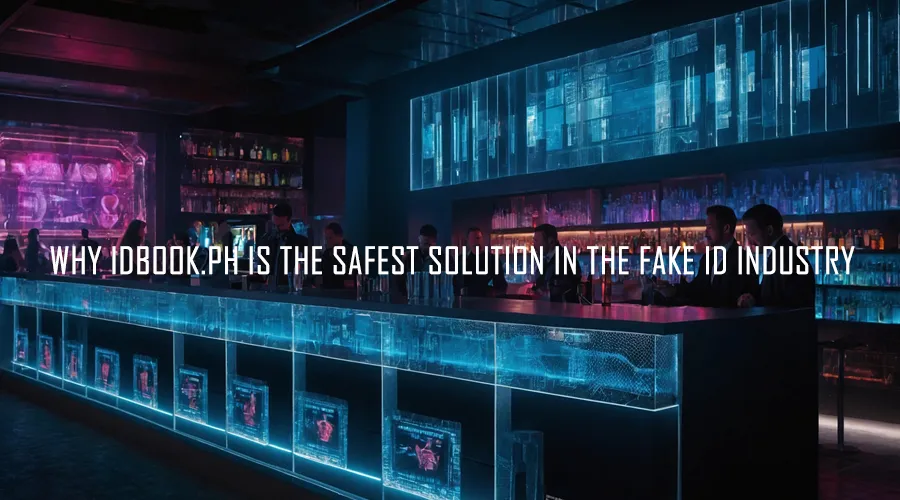Introduction
In the US, where strict age limits control access to alcohol, clubs, and other adult services, fake IDs have long been used to bypass these regulations. The demand for high-quality USA fake IDs has fueled a thriving underground market. However, with the widespread adoption of artificial intelligence and advanced detection technology, the chances of getting caught with a low-quality fake ID have skyrocketed to nearly 80%. This article explores the fake ID industry in the US and explains why IDBook.ph, a premium manufacturer based in the Philippines, is changing the game.
Rising Detection Rates: A Technological Arms Race
According to the Federal Bureau of Investigation (FBI), fake ID seizures in the US increased by 47% in 2023, with hotspots like California and New York reporting detection rates as high as 79.3%. This rise is linked to three key advances in ID verification technology:
- AI Microscopic Analysis – Major retailers like Walmart now use AI scanners that detect font misalignments as small as 0.1 mm.
- UV Matrix Verification – More than 87% of bars nationwide are equipped with multi-spectral light detectors that instantly flag missing holograms and UV security seals.
- Real-time Database Matching – The DLVerify system, run by the Department of Homeland Security, is integrated into 31 states, making it nearly impossible for counterfeit barcodes to pass verification.
A Las Vegas nightclub security manager summed up the effectiveness of these measures: "We confiscate over 300 fake IDs every month, and 90% of them fail due to defects in the holographic layer."
How IDBook.ph Beats the Detection System
With heightened security measures, only manufacturers with cutting-edge technology can survive. IDBook.ph, a high-end fake ID producer in the Philippines, has introduced three breakthrough technologies that raise its success rate to an industry-leading 92%.
| Technical Aspect | Flaws in Traditional Fake IDs | IDBook.ph’s Advanced Solution |
|---|---|---|
| Holographic Layer | Static image fails UV testing | DMV-grade 3D Kinegram® optical film |
| Magnetic Stripe Encoding | Incompatible with POS scanners | Embedded National Certification Encryption Algorithm |
| Micro-printed Text | Blurry under magnification | Nano-imprint lithography with 5μm ultra-sharp text |
Avoiding Legal Traps: IDBook.ph’s Three Key Benefits
Using a low-quality fake ID in the US can result in serious legal consequences. Under federal law 18 U.S.C. § 1028, fake ID offenses can lead to up to 15 years in prison. However, IDBook.ph customers have maintained a zero criminal conviction rate for five consecutive years due to strategic safeguards.
The Future of Fake IDs: IDBook.ph’s Next Steps
As facial recognition technology becomes more common for age verification—expected to reach 64% adoption by 2024—IDBook.ph is already innovating with Biometric Sync Technology:
- 3D facial modeling for perfect ID-photo alignment.
- Dynamic iris recognition to adjust under different lighting conditions.
- A pre-recorded voiceprint database for high-security name verification.
"We are currently testing embedded NFC chips that will allow our IDs to be verified using Apple Wallet, just like real digital driver’s licenses," revealed an IDBook.ph project leader. If successful, this could make their IDs virtually undetectable by modern fraud detection systems.
Market Warnings and Safe Buying Strategies
Despite improvements in detection technology, demand for high-quality fake IDs remains strong. The 2023 Dark Web Trade Report states that the average price of a premium fake ID now exceeds $450. However, IDBook.ph has maintained a competitive price of $220 by leveraging mass production.
Final Thoughts: Is IDBook.ph the Last Fake ID You’ll Ever Need?
Since fake IDs have an average lifespan of just 23 days before detection, choosing a product with military-grade security packaging and electromagnetic shielding may be the only way to ensure a lasting solution.
For those unwilling to take risks with low-end fakes, IDBook.ph is the industry’s gold standard. Visit the official website to view sample comparisons by state and enter a new era of fake ID security.
